Learn how to sew a slipcover for a wingback chair with this step by step video tutorial.
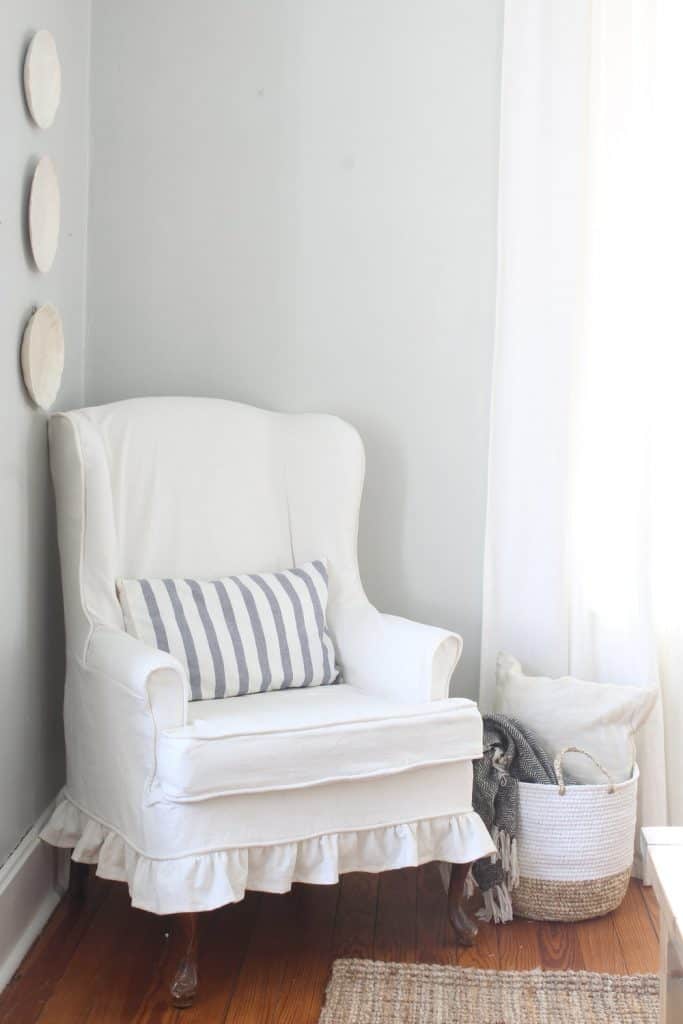
This post contains affiliate links for your shopping convenience. See my full disclosure HERE.
A Challenging Project
I have been sewing simple things for years now; dresses for my little girls, pillows, curtains, throw blankets and even simple slipcovers for our living room couches.
But, I must admit, this project challenged me.
This project was hard, but with patience and perseverance (and a few choice words) totally doable!
How to Slipcover a Wingback Chair Supplies
For this slipcover I used painter’s drop cloth that I bleached, a process I described in this post.
The drop cloth I use can be found HERE.
UPDATE MUST READ: I have heard from several readers that the brand of drop cloth you buy makes all the difference. I did not know this, since I have only ever used this brand from Amazon. Other brands turns gray and off white.
UPDATE PART TWO: Thanks to Lori, a lovely reader of my blog, I now know why some other brands won’t turn white. The drop cloths I recommend from Amazon are 100% cotton, so bleachable. Some brands are made with 50% polyester, so unbleachable. I knew people were having trouble with other brands, but now I actually know why!
Slipcovering is more about the process than an actual step by step tutorial.
To slipcover anything you just need to follow these rules
1. Follow the original seams and lines of the chair/couch/love seat
2. If you are adding piping, use the original chair as your guide. Put it in all the places that the original maker of the chair put it.
3. Pin the fabric tightly to the chair
4. Use a lot of pins and sew often.
This is not a quick process. You will want your chair near your sewing machine, so you can continually go back and forth to make sure everything is fitting okay.
You never want to pin and sew several seams at one time.
Always pin a little, sew it, and return to the chair to pin a little more.
Taking care to go slowly will ensure an excellent fit!
How To Slip Cover a Wingback Chair Instructions
To begin, I made enough piping to get me through the whole project.
To do this, I sandwiched 6/32″ cotton cord inside a four inch strip of bleached drop cloth.
I used a zipper foot to get the needle as close to the cord as possible, without sewing over it.
Next, I cut and draped all the pieces over the chair. (This will make waaay more sense in the video.) I cut pieces for the outside and inside of the wing, two pieces for the back, two pieces for the arms, two pieces for the front of the arms, two outside lower pieces, a piece for the front apron and a large piece for the front chair back (if that makes any sense at all).
I totally guesstimated all the sizes of the pieces.
Nothing has to be exact. The exactness will come with the pinning and sewing. 🙂
I started by overlapping the two back pieces and pinning them (right sides together) to the chair back piece.
It is really important to keep the chair back piece smooth and tight. It will the most visible in the finished slipcover.
Following the lines and seams of the original chair, I pinned the outside wing pieces to the back and to the inside wing pieces, which I also pinned to the front of the chair piece.
Have I lost you? It will make sense in the video.
You can see how many pins I used in this process. I wanted to be sure they would follow the lines of the chair, ensuring a nice fit.
I made sure the pins created a line for me to sew along.
While slipcovering I stop several times to be sure everything is still fitting.
Sometimes things may appear a bit wonky but might actually turn out when you pull it taut at another seam.
And remember that mine looked like it wasn’t going well halfway through, but turned out totally fine!
I could tell that I wasn’t going to have quite enough bleached drop cloth to finish my project, so I used unbleached drop cloth for the portion that would be hidden underneath the cushion.
Notice in the photo below how all the seams of my slipcover are along the original seams of the chair.
Use the piece as your guide.
This will allow you to slipcover anything.
After the main portion of the slipcover was finished, I added a ruffle and piping to the bottom edge to finish it off.
For the cushion, I created an envelope style cover, as opposed to using a zipper.
To make the pattern, I traced the shape of the cushion onto the drop cloth, leaving about a half inch on all sides for seam allowance.
For the bottom part of the cushion I cut two pieces that would overlap each ther for the cushion to fit inside.
I also cut a long strip that would go around the center of the cushion to join together the top and bottom pieces, with piping sandwiched between.
If you are on the fence about trying this, I encourage you to do it! As long as you go slow and check the fit often, you can totally do this.
You will be so proud of yourself for tackling the slipcover. 😉
You got this!
How to Sew a Slipcover for a Wingback Chair
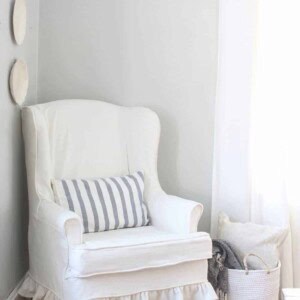
Equipment
- Sewing machine
Ingredients
- 100% cotton drop cloth
- sewing pins
Instructions
- For this slipcover I used painter’s drop cloth that I bleached (a process you can find on my blog!)
- This is not a quick process. You will want your chair near your sewing machine, so you can continually go back and forth to make sure everything is fitting okay. You never want to pin and sew several seams at one time. Always pin a little, sew it, and return to the chair to pin a little more. Taking care to go slowly will ensure an excellent fit!
- To begin, I made enough piping to get me through the whole project.
- To do this, I sandwiched 6/32″ cotton cord inside a four inch strip of bleached drop cloth. I used a zipper foot to get the needle as close to the cord as possible, without sewing over it.
- Next, I cut and draped all the pieces over the chair. (This will make waaay more sense in the video.) I cut pieces for the outside and inside of the wing, two pieces for the back, two pieces for the arms, two pieces for the front of the arms, two outside lower pieces, a piece for the front apron and a large piece for the front chair back (if that makes any sense at all).
- I totally guesstimated all the sizes of the pieces. Nothing has to be exact. The exactness will come with the pinning and sewing. I started by overlapping the two back pieces and pinning them (right sides together) to the chair back piece.It is really important to keep the chair back piece smooth and tight. It will the most visible in the finished slipcover.
- Following the lines and seams of the original chair, I pinned the outside wing pieces to the back and to the inside wing pieces, which I also pinned to the front of the chair piece.
Have I lost you? It will make sense in the video. - You can see how many pins I used in this process. I wanted to be sure they would follow the lines of the chair, ensuring a nice fit.
I made sure the pins created a line for me to sew along. - While slipcovering I stop several times to be sure everything is still fitting.Sometimes things may appear a bit wonky but might actually turn out when you pull it taut at another seam. And remember that mine looked like it wasn’t going well halfway through, but turned out totally fine!
- I could tell that I wasn’t going to have quite enough bleached drop cloth to finish my project, so I used unbleached drop cloth for the portion that would be hidden underneath the cushion. Notice in the photo below how all the seams of my slipcover are along the original seams of the chair. Use the piece as your guide. This will allow you to slipcover anything.
- After the main portion of the slipcover was finished, I added a ruffle and piping to the bottom edge to finish it off.
- For the cushion, I created an envelope style cover, as opposed to using a zipper. To make the pattern, I traced the shape of the cushion onto the drop cloth, leaving about a half inch on all sides for seam allowance. For the bottom part of the cushion I cut two pieces that would overlap each other for the cushion to fit inside.
- I also cut a long strip that would go around the center of the cushion to join together the top and bottom pieces, with piping sandwiched between. If you are on the fence about trying this, I encourage you to do it! As long as you go slow and check the fit often, you can totally do this.
Notes
- Follow the original seams and lines of the chair/couch/love seat
- If you are adding piping, use the original chair as your guide. Put it in all the places that the original maker of the chair put it.
- Pin the fabric tightly to the chair
- Use a lot of pins and sew often.
Nutrition information is automatically calculated, so should only be used as an approximation.
Pin it for later
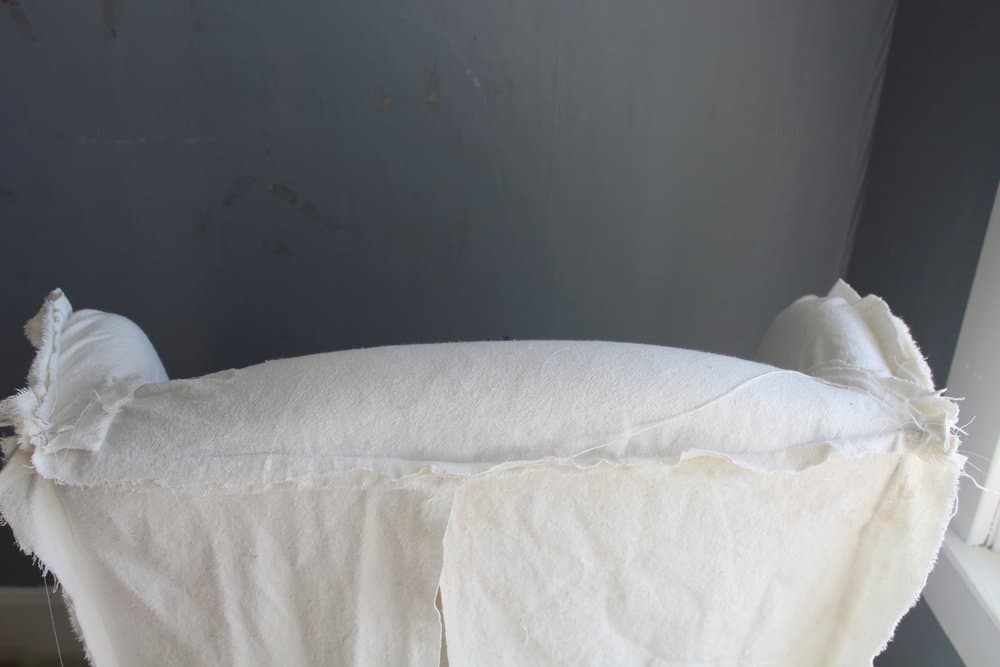
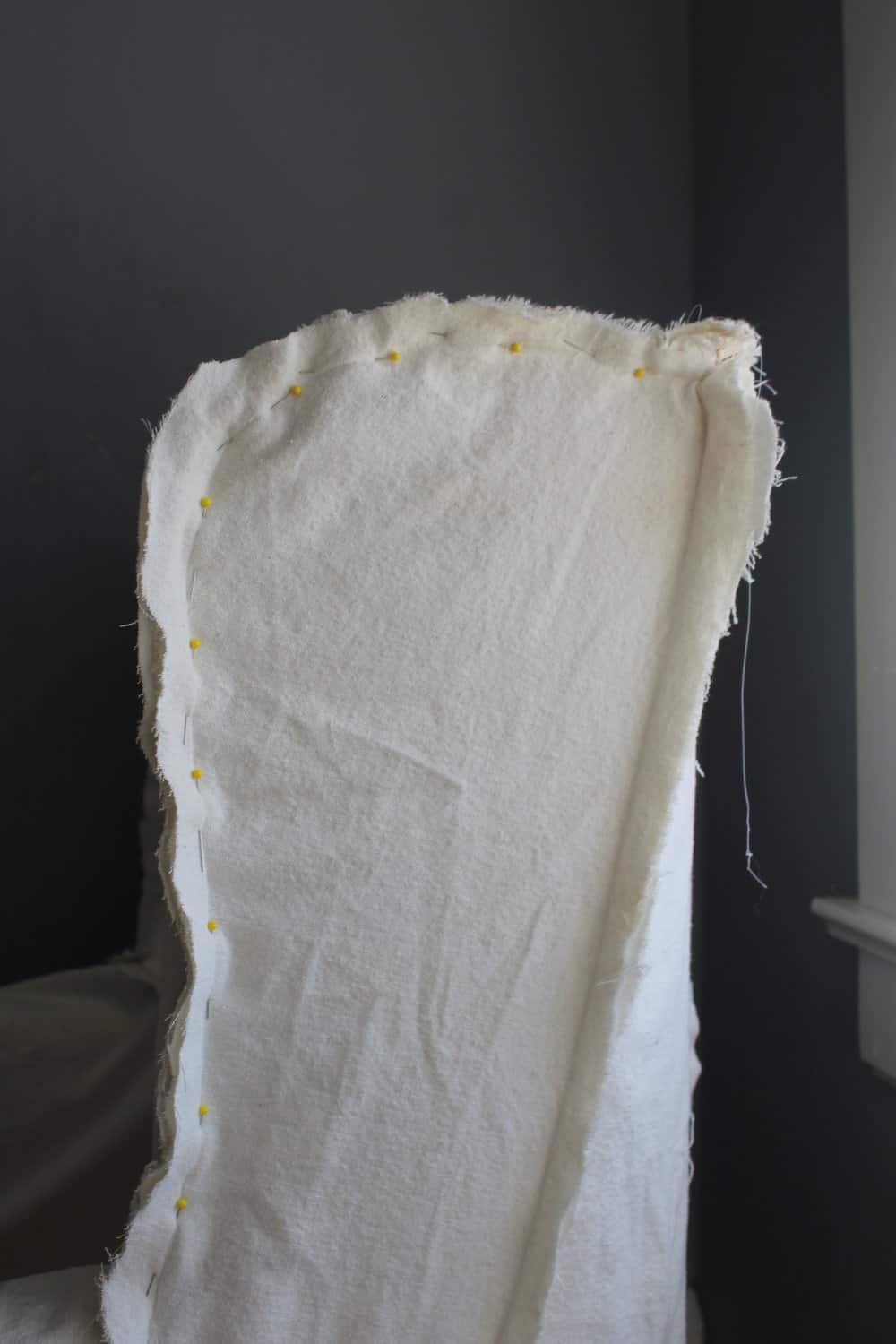
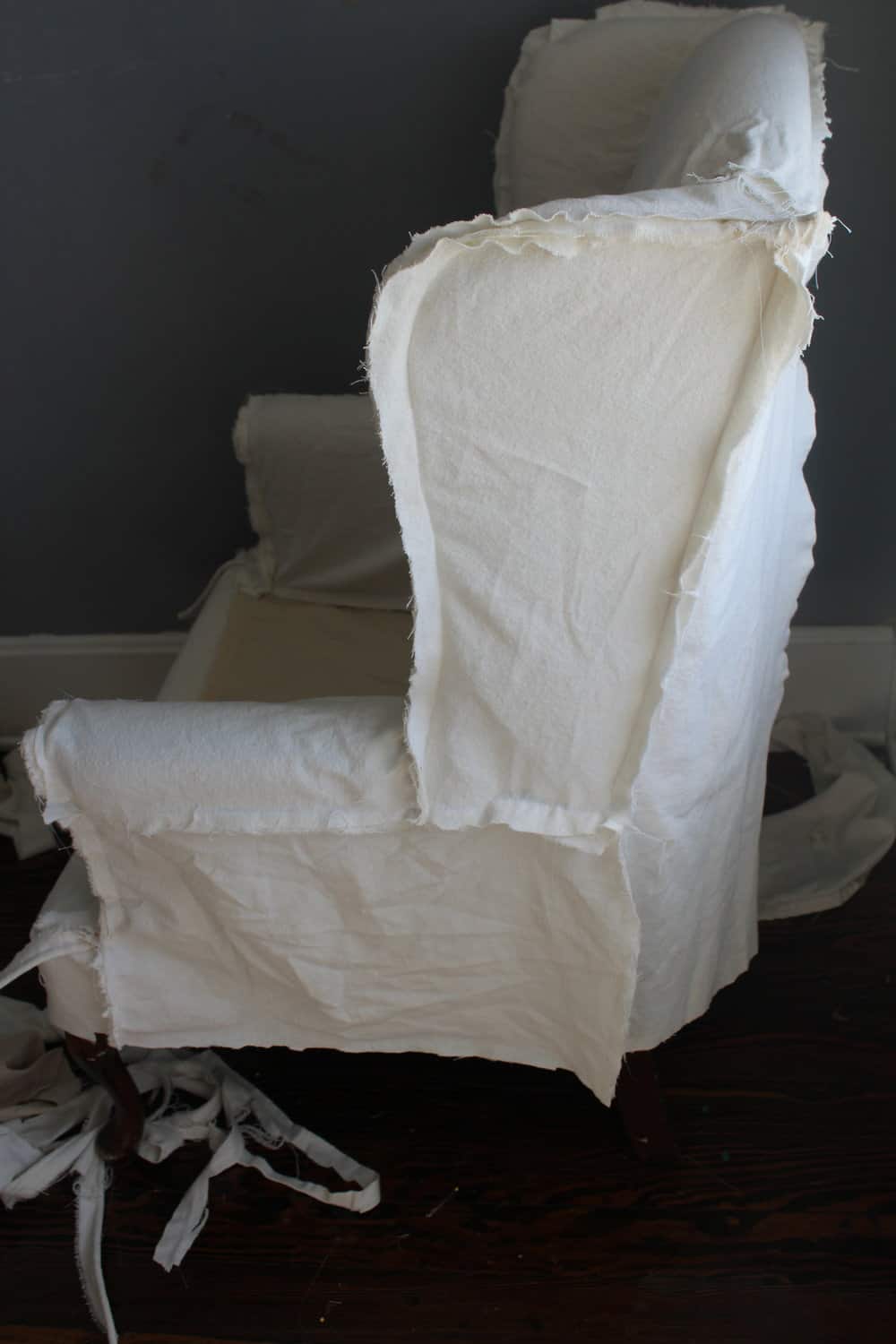
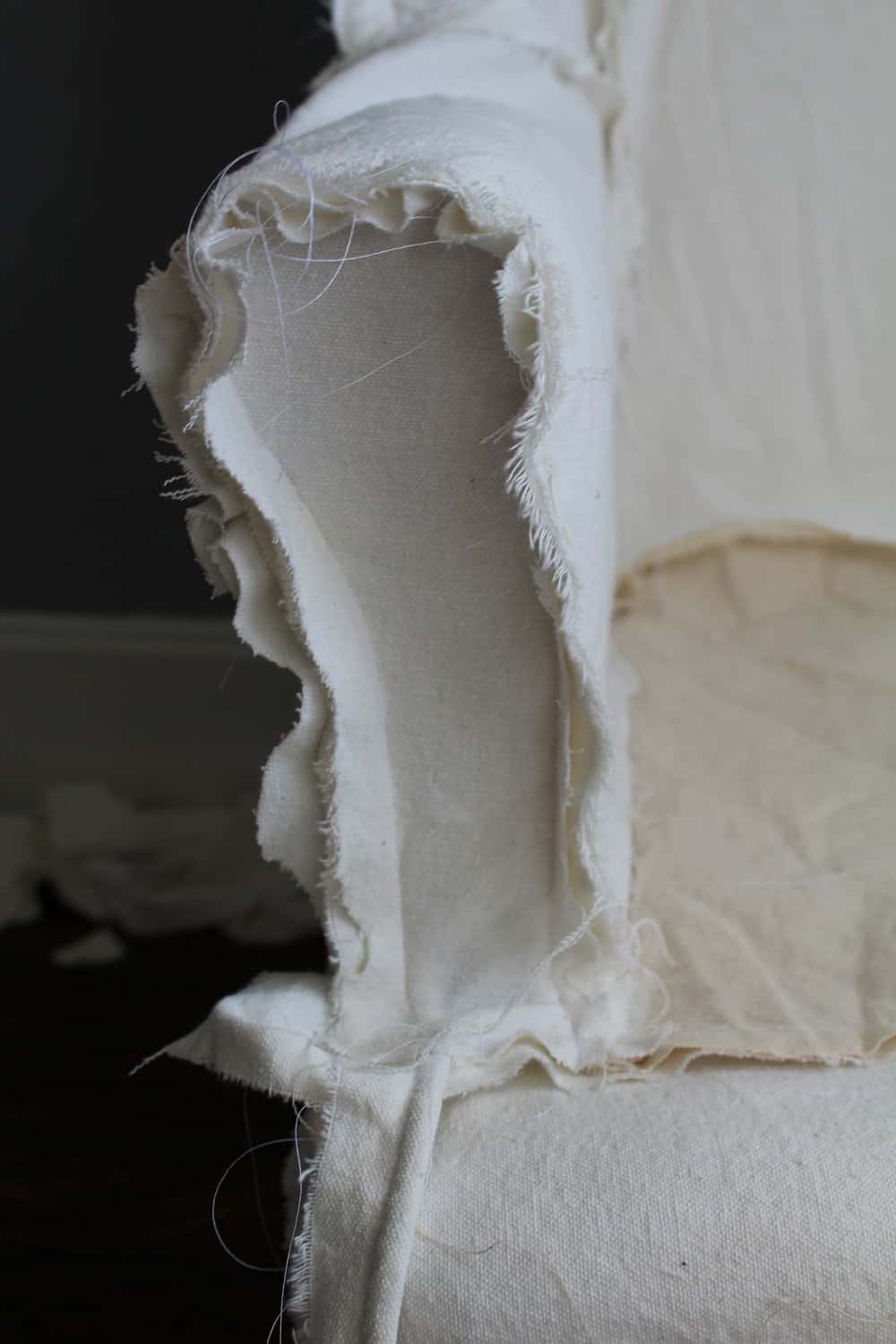
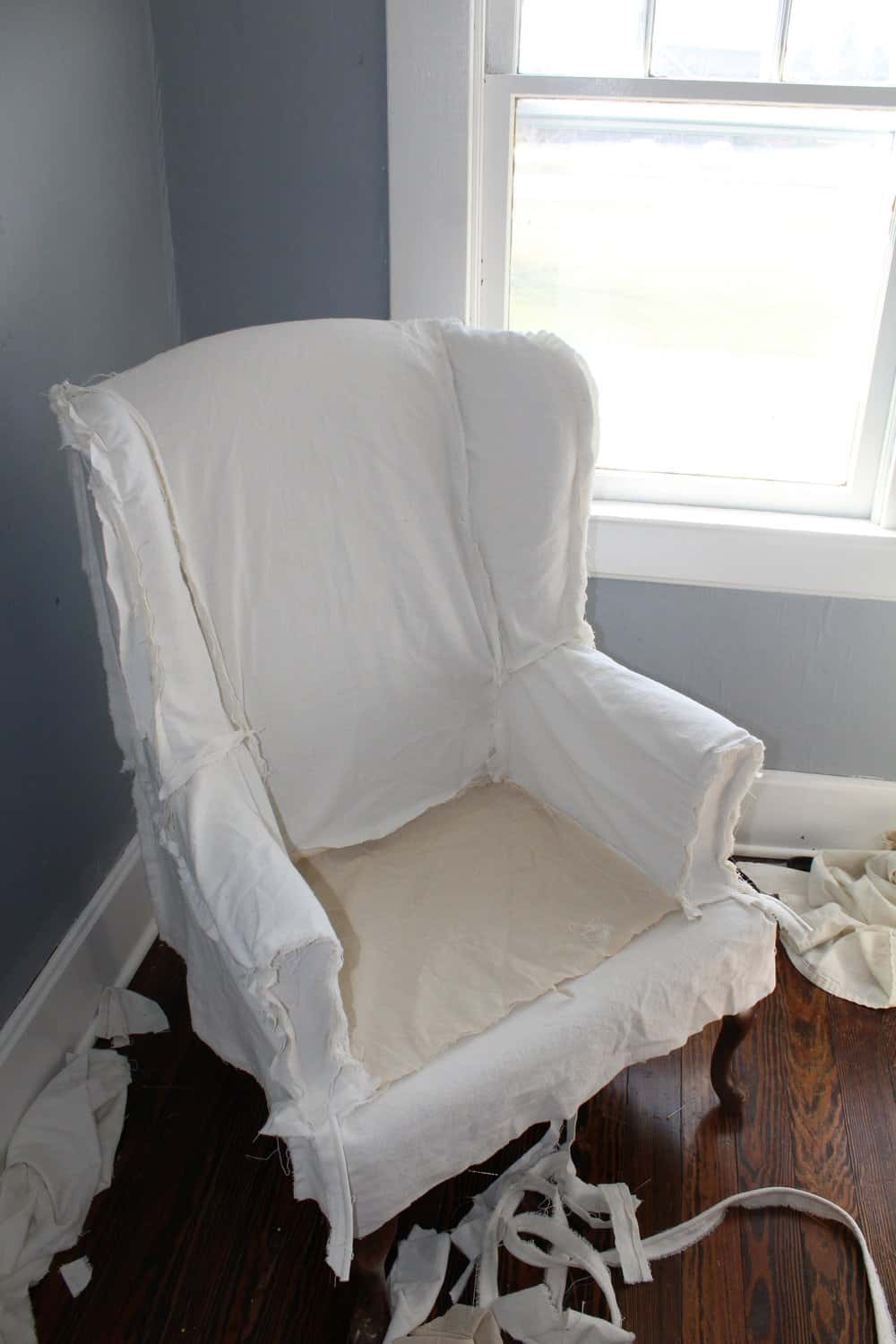
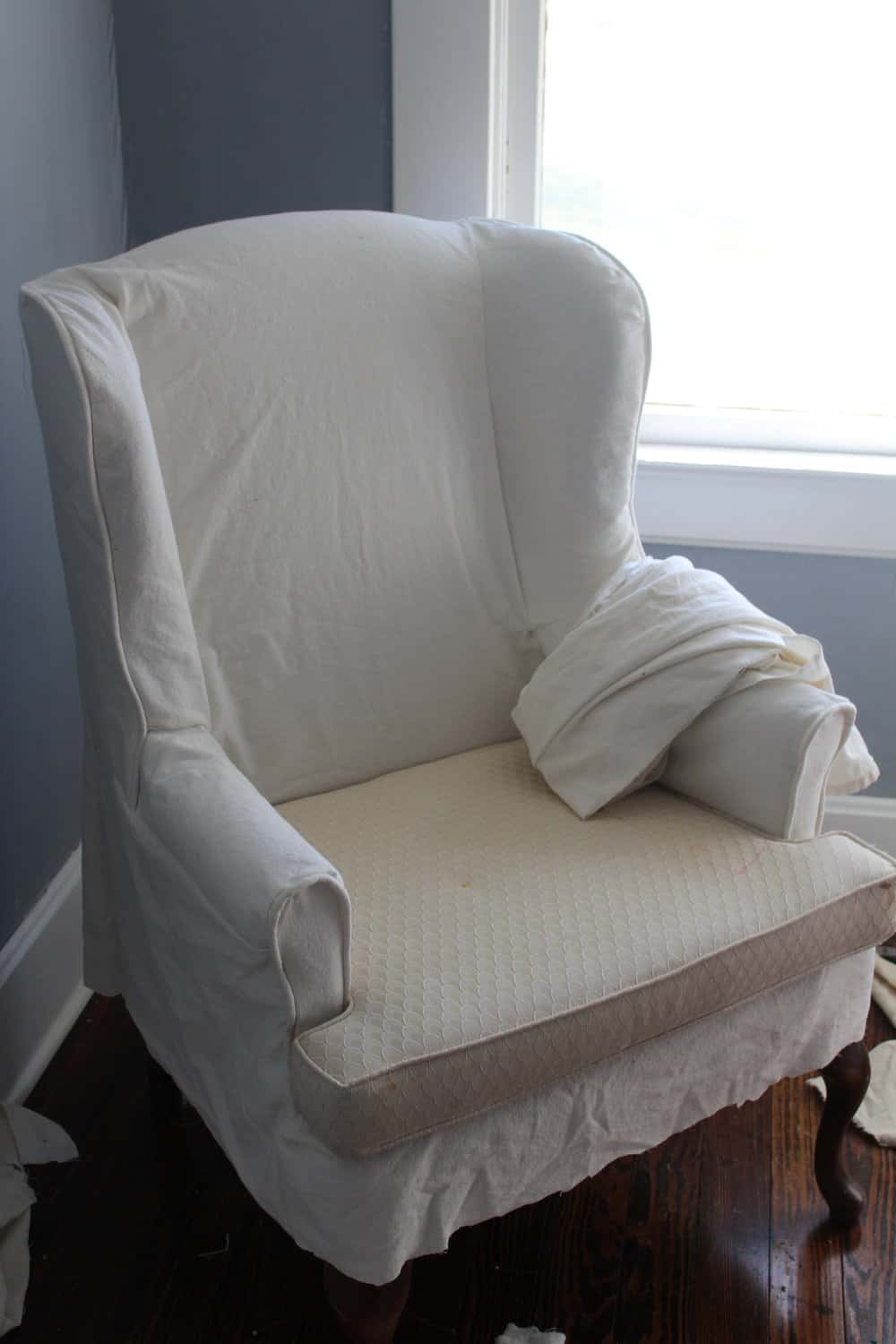
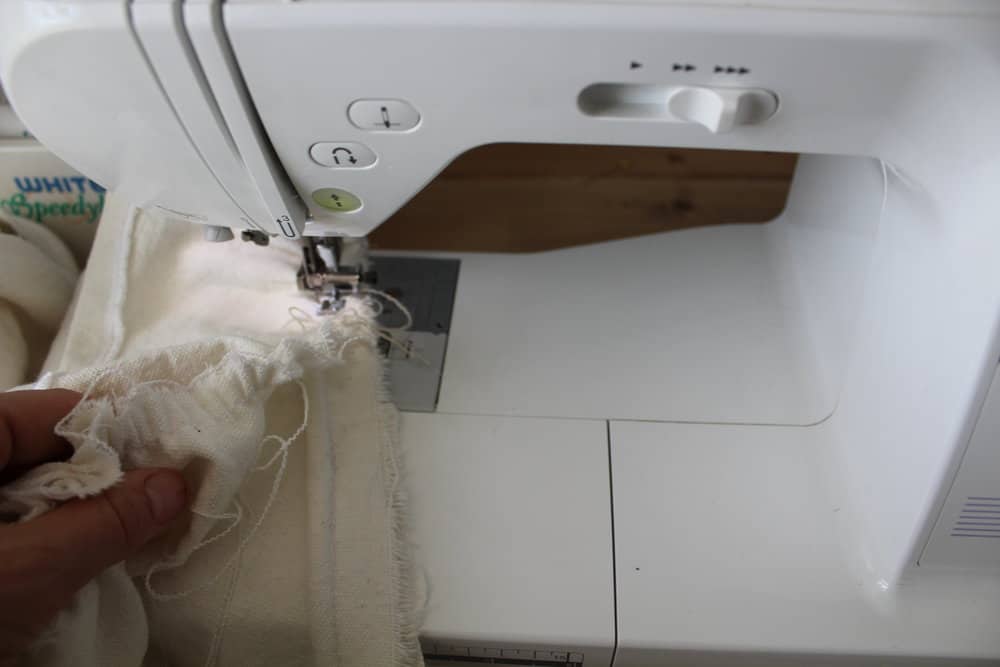
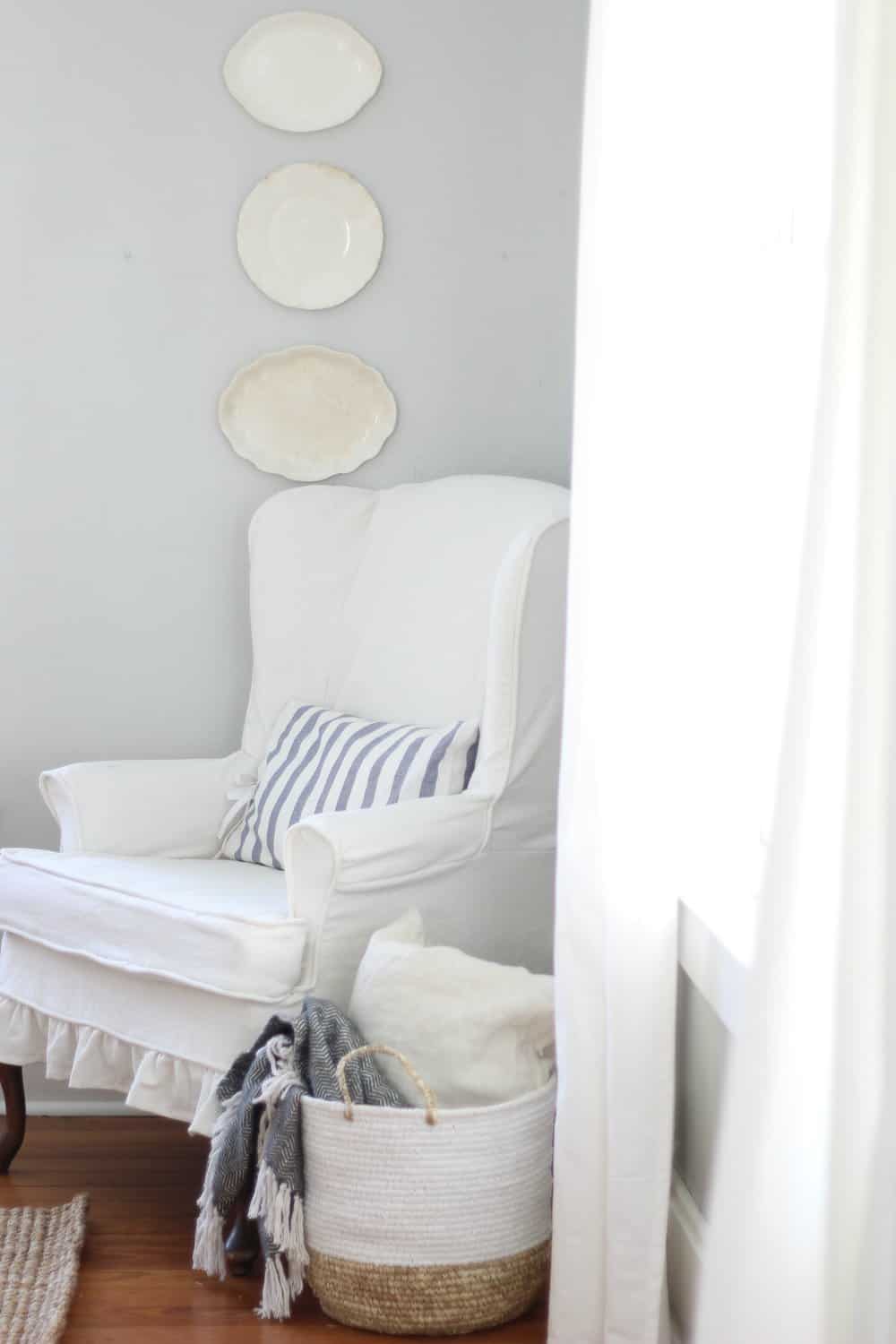
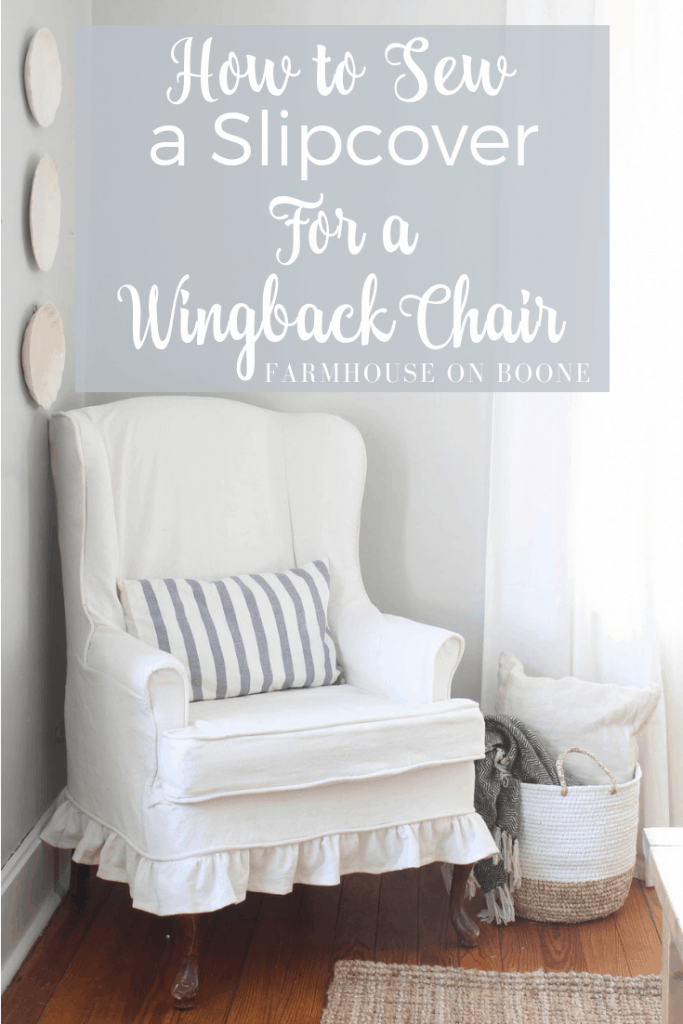
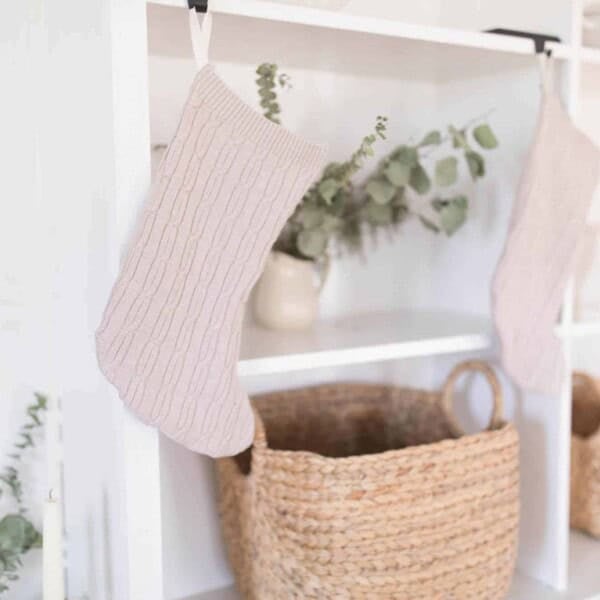


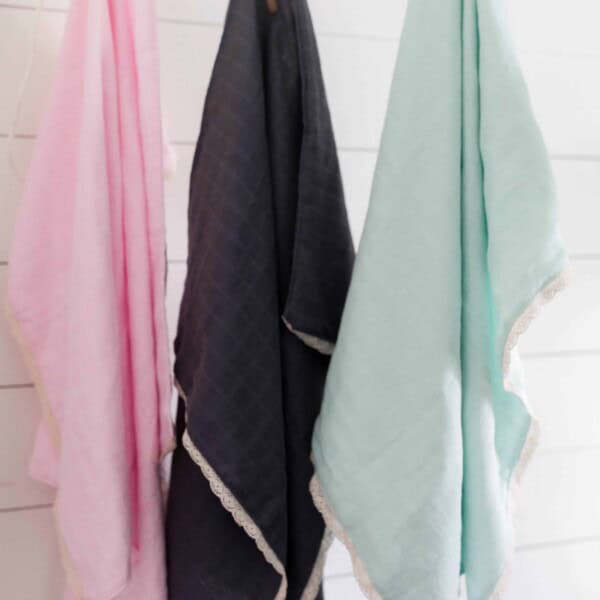






Hi, I love your slipcover look. Any chance if i provided pictures and measurements you would sew me a slipcover?
Michelle McQuillan
Hey Michelle! Sorry, but I am not taking on any orders for slipcovers. They are very custom to each individual chair, so I can’t go off measurements alone.
Do you fasten the back pieces in any way or do you let them hang free.
Thank you for the tutorial.
It might be worth pursuing if one wanted a more taut fit to put velco strips at the bottom of the chair and at the underside bottom of the cover. Just a thought.
Great tutorial. Thank you. How many metres of fabric would a wing back chair like that require?
I believe it took one package of drop cloth, if I remember correctly. I use the 9 foot by 12 foot. Not sure how many metres that is though!
Really fabulous and super helpful video! thanks, I feel so much more confident to try to make my own slipcover!
So glad this was helpful for you! Hope your slipcover process goes amazingly! 🙂
Do you remember how many orders of drop cloth (or yards) you needed for this chair?
You did amazing!!
And I appreciate that you made your own piping as well! Great touch
Thank you so much! I’m pretty sure it just took right at one. 🙂
Hi Lisa,
I enjoyed your tutorial on wingback slipcovers. I’ve reupholstered and slipcovered countless chairs in different styles. I know the answer to the problem of unsuccessful experiences bleaching slipcovers. The problem is fiber content. The drop cloths that you recommend from Amazon are 100% cotton and therefore are bleachable. The drop cloths that are sold in Home Depot by the brand Everbest are 50% cotton and 50% polyester, making them non-bleachable. Unfortunately, the fiber content is not listed on the packaging, but on a tag sewn into the hem of the cloth. Only 100% cotton fabric will bleach white and become soft from the process.
I hope this helps.
Lori
Wow, Lori! Thank you so much!! I had no idea what the difference was. That totally makes sense! I am going to add this to my posts!
Great tutorial – easy to understand and follow. I am currently making slipcovers for two wingback chairs.
I have a major question that I have researched for days and days, no answers anywhere that I can discover.
These are slipcovers and should just hang straight down toward the floor as I understand. Question: what
keeps the covers hanging properly since they cannot be secured underneath chair the way things are when
upholstered. Does the fit and the weight of the skirt do the job or is there something I should know about in advance? Any ideas, tips, suggestions most welcome. And then I may be overthinking this and it will not be a problem – who knows?
I don’t secure them to the chair in any way, so I guess it is just the weight of the fabric that keeps them down. I have never had a problem with that.
Hi Lisa,
You did an amazing job on your slipcover and you make it sound so easy even though I know it’s not.
I’m working up the courage to make a slipcover for a wingback I found. But before I begin I have a couple of questions that hopefully you can answer.
1. How many drop clothes did you use for this project ?
2. When you bleach the drop clothes, does the bleach "break down" or weaken the fibers of the drop cloth ?
3. Did you finish the seams of the slip cover so it wouldn’t ravel when washed ?
Thanks for sharing your wealth of knowledge. Love, love, love your home and blog.
Vanessa B
Hi Vanessa! Thank you for stopping by! I used two packages of the 9′ by 12′ drop cloth for this. I don’t notice that it breaks it down, but I’m sure it probably does do that a bit. I didn’t finish the seams, because of laziness, but I should have! Every time I wash my couch slipcovers, I get tons of strings. I really should run them through the serger! Thank you so much!
I can’t wait to see yours Katie!! If you have any questions don’t hesitate to ask!
Hello Lisa,
I’m curious what type of thread and needles you use when sewing drop cloth?
I’m studying your simple sewing sessions! I’m so excited!
Lori
CA.
hi Lisa, Is there a video or the tutorial.